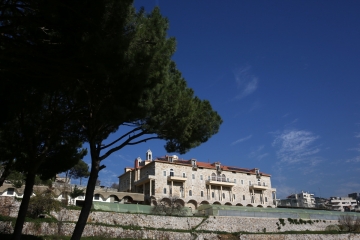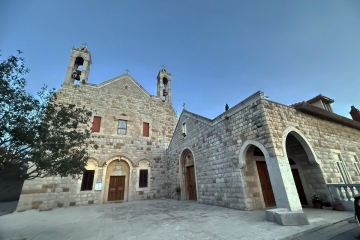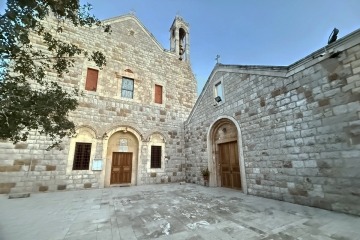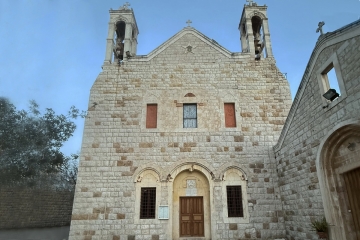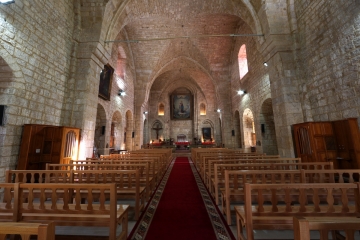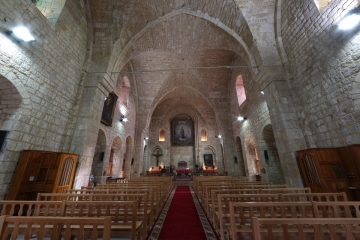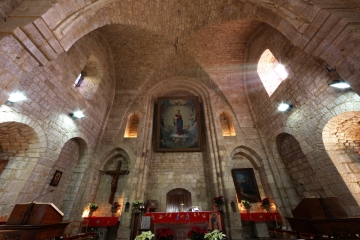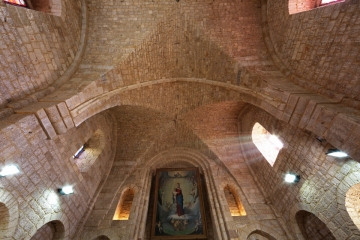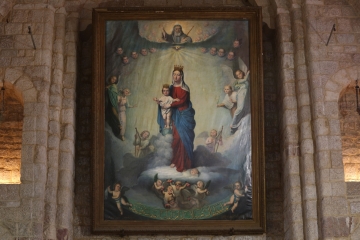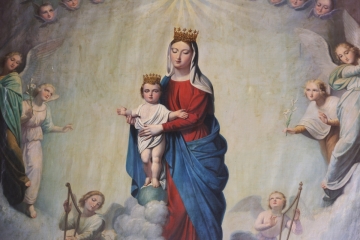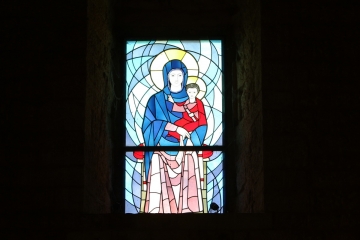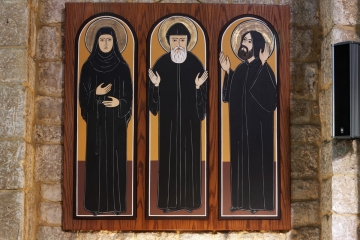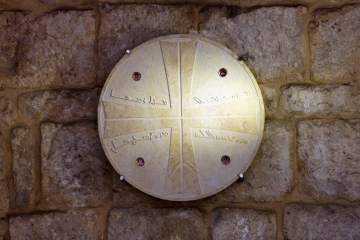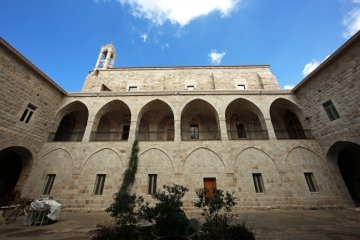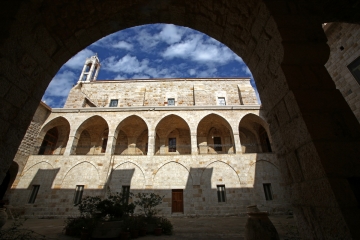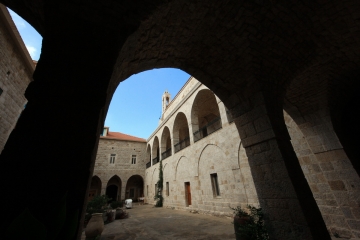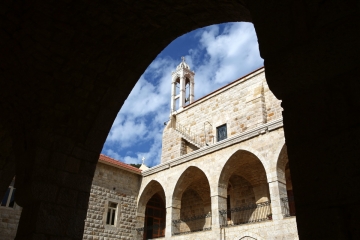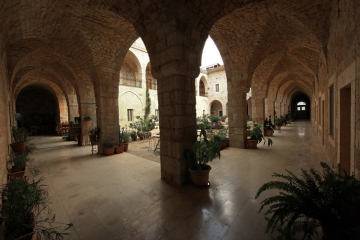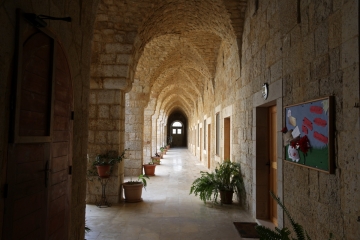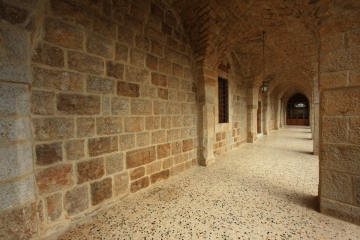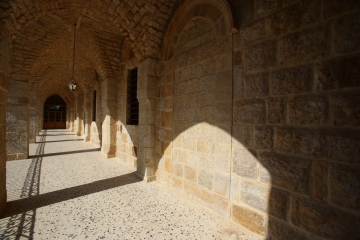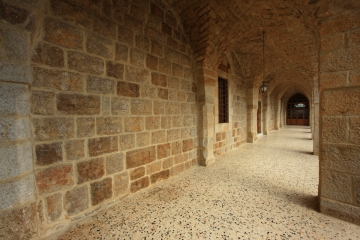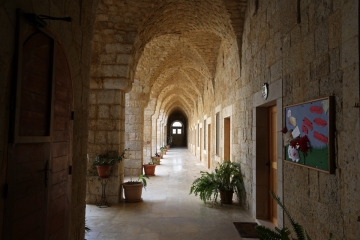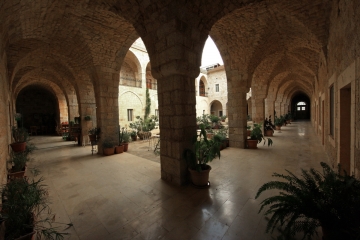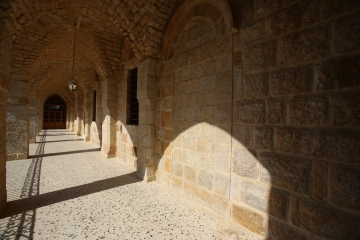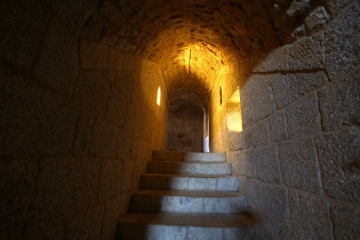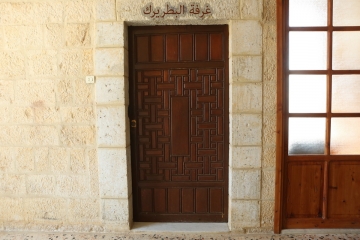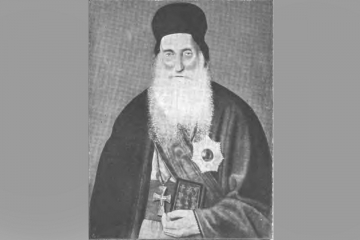دير سيّدة النصر - غوسطا
في الجِهة الشمالية من مَحلَة دُعيت منذ القديم باسم "بيت نِسبيه" Nessbay، كما يُستفاد من كلامٍ للأب انطوان مُقبل، يَقَع دير سيّدة نِسبيه التابع للرهبانية اللبنانية المارونية. ويَصِفَه أنطوان خويري في كتابه "تاريخ غوسطا" بأنه يقوم على هَضَبة مُقابل دير مار شلّيطا مقبس وفوق عين ماء تُدعى "عين عروس".
يعود تاريخ بناء هذا الدير إلى ما بين العامَين 1880 و1882، إذ بوشر به في التاريخ المذكور أولاً وأُنجِز بناؤه في التاريخ اللاحق أي بعد سنِتين، وكانت الغايةُ مِنه جَمعَ شملِ النشءِ الرهبانيّ وتوحيد تربيتِه وتوجيهِه.
ويتابع أنطوان خويري قائلاً إن كنيسة الدير بُنِيت حَسب أجمل فنّ ٍ معماريّ ٍ شَرقيّ. فَحنايا قناطرُها مَعقودَة بالحَجر، وقد تمَّ بناؤها سنة 1883،أي بعد سنةٍ من انتهاء بناء الدير. وتُشير الحِجَج والصُكوك العائدة له إلى أن الكنيسة كانت تَحمِل تارةً اسم "سيّدة النجاة" وطوراً اسم "سيّدة النصر" حتى أوآخر العام 1882، ثم استقرَّت على اسم "سيّدة النَصر" Notre dame de la Victoire. وهي مُزدانة بِصورة لمريم العذراء مرفوعة فوق المذبح الكبير.. من ريشة الفنّان داود القرم عام 1887، وهي تِحفة فَنّية رائعة الجمال، وتَحتَوي على 36 ملاكاً يَختَلِف كُلٌّ مِنهم عن الآخر. وقد خُطّتْ تَحتَ صورَة السيّدة العذراء في اللوحة العبارة التالية:
"قد بارَكَكِ الرَّبُّ بِقوَّته لأنه بكِ أفنى اعداءَنا. يهوديت، صفحة 13، عدد 22".
كذلك نقرأ إلى الجانب الأيمن من أسفل هذه اللوحة عبارة:
"باعتناء قُدس الأب العام مرتينوس غوسطاوي".
وتاريخ الانتهاء من بناء الكنيسة تُخلّده بلاطة رخامية مُثْبَتة فوق بابها الغربيّ، نُقِشَت عليها الأبيات الشِعرية التالية:
قد شاد للعلم في نِسبيه ريّسنا مرتينوس العامّ ديراً لُبَّ لبنــانِ
مع هيكل الله معزيّاُ لسيّـدةٍ تُعزى على النصر مزداناً باتقـانِ
قد جاء تاريخه ممّا يصادقه إذ تمَّ ما قيل: "أُعطيْ مجدَ لبنـانِ"
1883
وهي أبيات رديئة اللُغة والشاعرية كما هو واضح، من ذلك خُصوصاً ورود كلمة "مُعزيَّاً" في البيت الثاني التي يجب أن تكون "معزواً"...
وعلاوةً على دَوره التربويّ المُركّز على النشءِ الرهبانيّ يواصل ديرُ سيّدة النصر نشاطَه الزِراعيّ في نَقب الأراضي واستصلاحها.. في غوسطا وميروبا والكسليك، ويقوم بالخَدمات الرَعويّة فيه وفي القُرى المُجاورة، وبالتعليم المسيحيّ والرياضات الروحيّة.
أنشأ الدير، سنة 1979، بالتعاون مع الحَركة الرَسوليّة المَريميّة في غوسطا، "مَركَز سيّدة النَصر للثقافة الدينيّة" الذي يَؤمّه طُلاّبٌ من غوسطا والجوار.. فيؤمّن لهم دُروسًا ومُحاضراتٍ لاهوتيّةً وروحيّةً وثقافيّةً في شتّى المجالات.
وكان الدير قد أُصيب، في شتاء العام 1950، بِصاعقة هَدَمَت قَّبة جرس الكنيسة، وحَطَّمَت بعض الغُرَف وبعض الأشياء داخل الكنيسة، وذهب ضَحيتها أحد أساتذة المَدرَسة المُلحقة بالدير المُربّي جورج كميد، فانضوى شقيقه الأصغر، حبيب، في ما بعد في سلك الرهبنة اللبنانية المارونية مُتخذاً في الكهنوت اسم أخيه جورج، وغدا من ثم رئيساً على هذا الدير لمدةٍ طويلة.
ويُبرِز كتاب "تاريخ غوسطا" ما كان لدير نِسبيه من دورٍ كبير في تاريخ الرهبانية اللبنانية المارونية، إذ كان في بعض الفترات الزمنية مركزاً لرئاستها العامَّة، كما أقام فيه البطريرك يوحنا الحاج مع أساقفة الطائفة وحاشيته لمُدة ثلاث سنوات، في أثناء ترميم المقرّ البطريركي في بكركي، وفيه تلقّى هذا البطريرك دِرع التثبيت الذي أرسَله إليه البابا لاوون الثالث عشر(1878-1903)، لذلك اعتُبر من جُملة الأديار البطريركية. ويُشار إلى أن الغرفة التي كان يَشغلها البطريرك أصبحت اليوم بتصرّف رئيس الدير، ولا يزال بابها هو نفسه الذي كان في أيام البطريرك، وتُعرَف كيفية صِنعه الفنّي بأنها :"حفر وتنزيل".
نزيل دير سيّدة نِسبيه البطريرك يوحنا الحاج (1890-1898).
وُلد البطريرك يوحنا الحاج سنة 1818 في دلبتا الواقعة في قضاء كسروان، ووالده يعقوب الحاج كان قَس القرية. أرسله والده إلى مدرسة عين ورقة اللاهوتية لتلقّي العلوم، وكان يُديرها في حينه أحد أقاربه الشِدياق خاطر الحصروني، فأتقن فيها الرياضيات والفلسفة واللاهوت، واللغات العربية والسريانية واللاتينية والإيطالية، وبعد أن خَتَم دروسه رُقّي إلى درجة الكهنوت عام 1839.
دَرَس على يد الخوري يوحنا حبيب (المطران في ما بعد) مؤسس جمعية المرسلين اللبنانيين الموارنة ، أصول القضاء الروحي في المَحكمة الروحية المارونية وعاونه في مَهامِه، وخلفه بعد أن تقدَّم هذا الأخير بالسن، فغدا الحاج القاضي الأول في المَحكمة المَذكورة.
عام 1861، وفي 15 أغسطس تحديدًا، رقّاه البطريرك بولس بطرس مسعد (1854-1890). إلى درجة الأسقفية كمطران لأبرشية بعلبك التي كان المَجمَع اللبناني قد استحدثها عام 1736، وذلك خَلفًا لمطرانها المتوفى أنطون الخازن، وكان من أبرز أعماله خلال تولّيه شؤون هذه الأبرشية بناء مَقرّ لها في عرمون الواقعة في قضاء كسروان ألحق به مدرسةً إكليريكية لطُلاّب الأبرشية، كما بَنى إكليريكية أخرى بالقرب من بكركي تُشرِف عليها أبرشية بعلبك؛ وفي العام 1867، عندما سافر البطريرك مسعد إلى اسطنبول للقاء السُلطان عبد العزيز الأول، كان يوحنا الحاج من ضِمن الوفد المرافق.
جرى انتخابه بطريركاً في دير سيّدة بكركي في 28 نيسان سنة 1890.. بإجماع أصوات المطارنة المُجتمعين، وثبَّته البابا لاوون الثالث عشر (1878-1903) ومَنَحه دِرع التثبيت في 23 حزيران من العام نفسه، ولكنه لم يستطع تسلُّمه إلا في 2 شباط 1891.
قال عنه المطران يوسف الدبس في كتابه "تاريخ سوريا" إنه جدَّد دير بكركي على طرازٍ حديث.. تبعاً لتصميمٍ كان قد وضعه الأخ ليونار اللعازاري، فأعطى هذا التجديد للدير شكله الحاليّ. وقد نال بسعي نائبه المطران الياس الحويّك تجديد مدرسة الموارنة في روميه، كما نال من حكومة فرنسا ثماني كراسي لثمانية تلاميذ موارنة يتعلَّمون في معهد سان سولبيس بباريس، واشترى في القُدس داراً للموارنة يقيم فيها نائب بطريركيّ ويأوي اليها زوّار الأرض المقدَّسة من أبناء طائفته.
كذلك أوجد نيابةً بطريركية في باريس ينزل فيها أبناء الطائفة المارونية الذين يُسافرون إلى فرنسا، فتكون أشبه بسفارة للبطريركية في العاصمة الفرنسية.
وقد خصَّ الكرسيَّ البطريركيَّ بِبعض الأراضي التي ابتاعها، وأفرَدَ قِسماً منها ليُقام عليها معهد عالٍ للإكليريكيين بجانب الكرسيّ البطريركيّ، وأوقف أملاكاً وأراضي واسعة لمعهد عين ورقة.
كما حارب عادة المُقامرة التي تَفشَّت بين الرعايا في أيامه، وأدَّت إلى إلحاق الكوارث بالعائلات، مُصدراً مناشير تبيّن الأضرار البالغة الناشئة عن ذلك وتُحرّم تعاطي هذه اللعبة السيّئة.
دعم هذا البطريرك أيضًا عمل الإرساليات الكاثوليكية اللاتينية الوافدة إلى لبنان وسوريا من يسوعيين وفرنسيسكان وغيرهم ومَدَح دومًا أعمالهم.. رغم اعتراض الأوساط المحافظة في الطائفة، كما كانت علاقته جيّدة مع السُلطات العثمانية التي كان على رأسها حينذاك السلطان عبد الحميد الثاني الذي كان هذا البطريرك في طليعة مَن التقاهم. وقد أصدر عدة مناشير تَعضُد "السلطنة السَنية"، ثم تبرَّع بمبلغ ستة آلاف فرنك بعد زلزال القسطنطينية وحضّ الموارنة على التَبرّع لذلك.
أهداه العثمانيون وسامَي المجيدي والعثماني والميدالية الذهبية، فضلاً عن ترقية عدد من الموارنة إلى مناصب عليا في الدولة. فقد غدا سليم باشا الملحمة وزيرًا للزراعة والغابات في اسطنبول، ونجيب بك أفندي الملحمة موفدًا باسم السلطان إلى إمارة بلغاريا، وسعادة شديد بك حبيش قُنصلاً عامًا للدولة العثمانية في فرنسا بعد أن تَقلّبَ في قُنصليات أخرى، وقد كتب مؤرّخ البطاركة الموارنة الخورأسقف يوسف داغر "أن الطائفة بهذه التعيينات قد نَمَت عزًا وفخارًا".
ونقل المؤرخ والأسقف الماروني يوسف الدبس عنه أنه عندما وقعت فِتنة العام 1860 رَفَض الحاج التوقيع على صَك المُصالحة، "ولم يَثنِه عن عزمه وعيد ولا تهديد".
وكان هذا البطريرك يَتَمَتَع بتقديرٍ وافر من جانب جميع الأوساط الدينية والزمنية في عَصره في الوطن وخارجه، وفي كتاب بعنوان "القلادة العَسجَدية في مدائح مار يوحنا بطرس الحاج بطريرك الطائفة المارونية" جمع الأب لويس زيادة كل ما قيل نَثراً وشِعراً في مَدِح هذا البطريرك الجليل سواء في الصُحف الوطنية أو الاجنبية، وما قيل عنه في مُناسباتٍ مُختلفة، وكلَّها إشادة بمزاياه الروحية والخُلُقية وبشخصيَّته الرفيعة العالية الصفات.
وقد روى عنه الخورأسقف يوسف داغر انه كان يقول: "إذا كانت عظامي تَنفَع الطائفة فَخِذوها وإجعلوها مَحرقةً في سبيل خيرها".
أسلم الروح في 24 كانون الأول 1898 ودُفن في البدء في كنيسة الصرح البطريركي ببكركي، وعندما شُيّدت المقابر الجديدة نُقل رفاته اليها، حيث يوجد لوحة تؤرّخ تاريخ وفاته نقرأ عليها ما يلي:
"أنا يُوحنَّا أخوكم وشريكُكُمّ في الضّيق وَفي الملكُوت رُؤيا ف1 عدد9
ههُنا رقدَ بالربِّ عَلىَ رَجَاء القيَامَة الطيِّبُ الذكرِ والأثرْ البَطريَرك يوحَنّا بطرسُ الحَاج.
ارتقَى إلى البَطِريَركيَّة في 27 نيسان سنة 1890، وَتوفيِّ في 24 كانون الأول سنة 1898".
The monastery of Our Lady of Nesbay – Ghosta
According to Father Antoine Mokbel, the monastery of Our Lady of Nesbay belongs to the Lebanese Maronite Order. Professor Antoine Khoueiri describes it in his book “The History of Ghosta” as standing on a hill opposite the Mar Shallita monastery Moqbes and above a spring of water called “Ain Arous.” The stones with which the church was built were brought from quarries located in its vicinity. The construction of the monastery started in 1880 and ended two years later.
It aimed to unite the monastic youth and unify their upbringing and education.
Professor Antoine Khoury adds that the monastery church was built according to the most beautiful oriental architecture. Its arches are knotted with stone, and it was built in 1883, a year after the construction of the monastery was completed. Documents related to it indicate that the church was sometimes called “Our Lady of Assistance” and sometimes called “Our Lady of Victory” until the end of the year 1882, when the name “Our Lady of Victory” was settled on. It is decorated with a picture of the Virgin Mary raised above the great altar, the artist Daoud Al-Qorm, 1887. It is a masterpiece of great beauty and showcases 36 angels, each different from one another. Under the image of the Virgin in the painting is written the following phrase:
“The Lord has blessed you with his power because through you he has consumed our enemies. Yehudit, p. 13, No. 22”.
We also read to the right side of the bottom of this painting the phrase:
“With the care of the Holy Father General Martinos Ghostawi”.
The date of the completion of the church’s construction is commemorated by a marble slab installed above its western door on which the following poetic verses are engraved:
“He built a monastery in the heart of Lebanon
A temple of God, and of a woman who was embodied victory, adorned with perfection
Its history came to confirm it, as what was said was fulfilled: “Glory to Lebanon.”
1883
It is, however, clear that these are poorly literal and badly written poetic verses.
In addition to its educational role focusing on monastic formation, the Convent of Our Lady of Victory continues its agricultural activities and the excavation and reclamation of lands in Ghosta, Mayrouba, and Kaslik, and carries out pastoral services there and in the neighboring villages, in addition to Christian education and spiritual retreats.
The monastery was established in 1979, in cooperation with the Marian Apostolic Movement in Ghosta, the “Our Lady of Victory Center for Religious Culture”, which is attended by students from Ghosta and the neighborhood. It provides them with theological, spiritual, and cultural lessons and lectures in various fields.
The monastery was hit, in the winter of 1950, by a lightning strike that demolished the church bell dome and destroyed some rooms and some items inside the church. One of the teachers of the school, the educator George Kmeid, was killed. His younger brother, Habib, later joined the Lebanese Maronite monastery, taking in the priesthood the name of his brother George; he became the head of this monastery for a long time.
The book "The History of Ghosta" highlights the great role of the monastery in the history of the Lebanese Maronite Order, as it was in some periods a center for its general presidency, and Patriarch Youhanna El-Hajj resided there with the bishops of the community and his entourage for three years during the restoration of the patriarchal headquarters in Bkerki. It is also in this monastery that this patriarch received the shield of confirmation sent to him by Pope Leo XIII (1878-1903), that is why it was considered one of the patriarchal monasteries. It is noteworthy that the room occupied by the patriarch is today at the disposal of the head of the monastery, and its door is still the same as it was in the days of the patriarch.
The resident of the Monastery of Our Lady of Responsibility, Patriarch Youhanna El Hajj (1890-1898)
Patriarch Youhanna Al-Hajj was born in 1818 in Dlebta, located in the Keserwan District, and his father, Yaqoub Al-Hajj, was the priest of the village. His father sent him to Ain Waraqah Theological School to learn the sciences. It was run by one of his relatives, Deacon Khater Al-Hasrouni, and there he mastered mathematics, philosophy, theology, and Arabic, Syriac, Latin, and Italian languages. After completing his studies, he was promoted to the priesthood in 1839.
He studied under the priest Youhanna Habib (later the bishop) founder of https://en.wikipedia.org/wiki/Kreimists, the origins of the spiritual judiciary in the Maronite spiritual court and assisted him in his duties, and succeeded him after the latter’s age no longer permitted him to be active. He became the first judge in the aforementioned court.
In 1861, and specifically on August 15, Patriarch Boulos Boutros Massad (1854-1890) promoted him to the rank of bishop, as Metropolitan of the Diocese of Baalbek, which the Lebanese Synod had established in 1736, in succession to its deceased Archbishop Anton El-Khazen. One of his most prominent achievements during his tenure of the affairs of this diocese was the building of its headquarters in Aramoun, located in the Kesrouan district. He attached a seminary for the students of the diocese to it. He also built another seminary near Bkerki, which is supervised by the Diocese of Baalbek. In 1867, when Patriarch Massad traveled to Istanbul to meet Sultan Abdul Aziz I, Youhanna Al-Hajj was part of the accompanying delegation.
This patriarch was highly regarded by all the religious and temporal circles of his time at home and abroad, and Father Louis Ziadeh collected everything that was said in prose and poetry in praise of this venerable patriarch, both in national or foreign newspapers and what has been said about him on various occasions, all of which praising his spiritual and moral qualities and his exalted personality, and published a book on the topic.
He was elected patriarch in the monastery of Our Lady of Bkerke on April 28, 1890, by the unanimous vote of the metropolitans gathered, and Pope Leo XIII (1878-1903) confirmed him and granted him the shield of confirmation on June 23 of the same year, but he could not receive it until February 2, 1891.
Bishop Youssef Al-Dibs said about him in his book “The History of Syria” that he renovated the Bkerki monastery in a modern style, based on a design by Brother Leonard Al-Azari, and this renovation gave the monastery its current shape. Through the efforts deployed by his deputy, Archbishop Elias Howayek, he obtained the right to renovate the Maronite school in Roumieh. He also obtained from the Government of France eight chairs for eight Maronite students studying at the Saint-Sulpice Institute in Paris. He bought a house for the Maronites in which a patriarchal representative resides and the pilgrims of his sect were accommodated in the Holy Land.
He also created a Patriarchal Vicariate in Paris where the members of the Maronite community who travel to France would stay and which acted like an embassy for the Patriarchate in the French capital,
He allocated the Patriarchal See some of the lands that he bought, and dedicated a part of those lands to the establishment of a high institute for clergymen next to the patriarchal chair, and endowed the Ain Warqa Institute with large properties and lands.
He also fought against the habit of gambling that spread in the parishes in his days and led to disasters in some families, issuing pamphlets explaining the severe repercussions of these games and forbidding it.
This patriarch also supported the work of the Latin Catholic missionaries coming to Lebanon and Syria, including Jesuits, Franciscans, and others, and he always praised their work, despite the objections of conservative circles in the sect. His relationship was good with the Ottoman authorities, which was headed at the time by Sultan Abdul Hamid II, who was at the forefront of those who met with this patriarch. His Beatitude issued several pamphlets supporting the "Sunni Sultanate", and donated six thousand francs after the Constantinople earthquake, urging Maronites to do the same.
The Ottomans presented him with the most honorable Ottoman medal, in addition to promoting several Maronites to high positions in the state. Selim Pasha al-Malhamah became Minister of Agriculture and Forests in Istanbul, Najib Bey Effendi al-Malhamah was delegated on behalf of the Sultan to the Emirate of Bulgaria, and His Excellency Chedid Bey Hobeish became Consul General of the Ottoman Empire in France. The historian of the Maronite patriarchs, Bishop Youssef Dagher, wrote, “With these appointments, the sect has grown in honor and pride.”
The Maronite historian and bishop Youssef Al-Debs quoted him as saying that when the strife occurred in the year 1860, Al-Hajj refused to sign the deed of reconciliation, “and he no threat or promises could shake his resolve”,
Archbishop Youssef Dagher reported him saying: “If my bones benefit the community, take them and burn them for the sake of its sake.”
He passed away on December 24, 1898, and was initially buried in the church of the Patriarchal Monument in Bkerki. When the new cemeteries were built, his remains were transferred there, where there is a plaque that commemorates his death, on which we read the following:
“I am John, your brother, and companion in tribulation and the kingdom of God. Revelation 1 verse 9”
“Here, in the Lord, resting in the hope of the Resurrection, lies the good Patriarch, John Boutros Al-Hajj.
He was promoted to the patriarchate on April 27, 1890, and died on December 24, 1898.”
